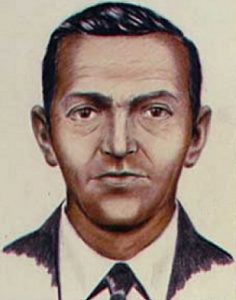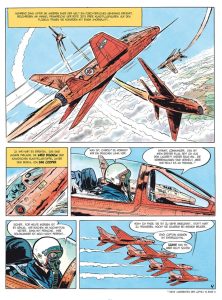D.B. Cooper, Comic Strip aviator Dan Cooper and the F-100.

All of us know the story of D.B. Cooper, the man who jumped into the night with $200k after hijacking Northwest Orient Airlines Flight 305, a Boeing 727 aircraft on November 24, 1971. Cooper claimed he had a bomb in his briefcase and made the flight crew land in Seattle. He let the passengers out and collected his bag of money and five parachutes to avoid someone modifying a single chute.
A small crew got back onboard the aircraft and Cooper asked to be flown to Mexico. Cooper told the aircrew to “fly at the minimum airspeed possible without stalling the aircraft—approximately 100 knots (185 km/h; 115 mph)—at a maximum 10,000-foot (3,000 m) altitude. He further specified that the landing gear remains deployed in the takeoff/landing position, the wing flaps be lowered 15 degrees, and the cabin remain unpressurized.”(1) He also insisted that the rear exit door remain open and its airstair extended. At some point on that second flight, he jumped out of the rear of the plane somewhere over southwestern Washington, never to be heard from again. Although some of the cash was found on the shore of the Columbia River many years later, most of the money has not been recovered
The FBI kept the case open for over 45 years. When the agency suspended the case in 2016, they determined that Cooper likely did not survive the jump.
“The hijacking had major implications for commercial aviation and airport security. Cooper’s brazen hijacking, and a slew of Cooper imitators in the following year, caused security procedure to become stricter. Metal detectors and compulsory searching of baggage became standard and paying for flights the same day of their departure with cash became a cause for scrutiny. Aircraft design was modified with Cooper vanes that would prevent the aft staircase from being lowered while in flight. By 1973, the pace of hijackings greatly slowed as the new security measures successfully dissuaded would-be hijackers whose motive was only money.”(1)
But what has this to do with the F-100?
 The ticket for DB Cooper was originally in the name Dan Cooper. A mistake by reporters was the origin of the DB Cooper name. Some investigators think that Dan Cooper was the name taken by the hijacker with a nod to the comic book character. “Dan Cooper (also known as Les Aventures de Dan Cooper) is a Franco-Belgian comics series about a fictional Canadian military flying ace and rocketship pilot…The Cooper Research Team led by Tom Kaye, working in cooperation with Seattle-based FBI agent Larry Carr, speculated that the hijacker may have chosen an alias based on the fictional character. Kaye and colleagues suggest the hijacker may have been exposed to the comics while on a tour of duty in Europe, or that he may have been of French-Canadian origin. Some of the comics’ storylines seemingly match aspects of the D. B. Cooper case, including jumping out of a plane with a parachute, as well as a ransom being delivered in a knapsack.”(2)
The ticket for DB Cooper was originally in the name Dan Cooper. A mistake by reporters was the origin of the DB Cooper name. Some investigators think that Dan Cooper was the name taken by the hijacker with a nod to the comic book character. “Dan Cooper (also known as Les Aventures de Dan Cooper) is a Franco-Belgian comics series about a fictional Canadian military flying ace and rocketship pilot…The Cooper Research Team led by Tom Kaye, working in cooperation with Seattle-based FBI agent Larry Carr, speculated that the hijacker may have chosen an alias based on the fictional character. Kaye and colleagues suggest the hijacker may have been exposed to the comics while on a tour of duty in Europe, or that he may have been of French-Canadian origin. Some of the comics’ storylines seemingly match aspects of the D. B. Cooper case, including jumping out of a plane with a parachute, as well as a ransom being delivered in a knapsack.”(2)
While watching a newly released documentary on DB Cooper, there were scenes of some of the Dan Cooper comic books. On several pages, I noticed a very familiar aircraft. It’s the F-100. I checked with a very knowledgeable source to be certain that it was indeed our much-loved Hun. The expert verified my suspicions, Take a look for yourself… The legend of DB Cooper is thriving even today. There are DB Cooper amateur sleuths online and professional detectives still determined to find out who DB Cooper was. “Cooper Con” conventions are held in Alaska. There are theories that believe DB Cooper was a woman named Barb Dayton, and there at least 50 other suspects. What is known, is that if DB Cooper was alive today, he/she would be in their mid-90s.
The legend of DB Cooper is thriving even today. There are DB Cooper amateur sleuths online and professional detectives still determined to find out who DB Cooper was. “Cooper Con” conventions are held in Alaska. There are theories that believe DB Cooper was a woman named Barb Dayton, and there at least 50 other suspects. What is known, is that if DB Cooper was alive today, he/she would be in their mid-90s.
By MB Barrett c. 2022
You can see the new release “DB Cooper, Where Are You?” on Netflix, watch for those F-100s, and the film The Legend of D.B. Cooper: What Happened to History’s Most Famous Hijacker? on History.net.
Sources: (1) Wikipedia.org/wiki/D._B._Cooper; (2) wikipedia.org/wiki/Dan_Cooper_(comics)
